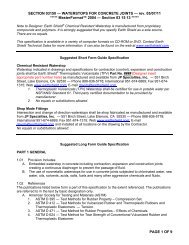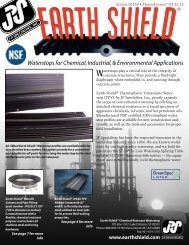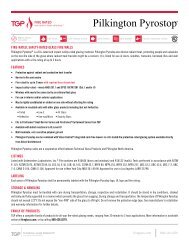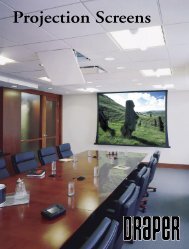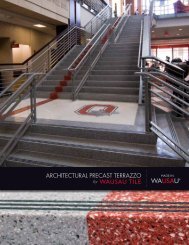National Gypsum Construction Guide
National Gypsum Construction Guide The entire - AECinfo.com
National Gypsum Construction Guide The entire - AECinfo.com
- No tags were found...
Create successful ePaper yourself
Turn your PDF publications into a flip-book with our unique Google optimized e-Paper software.
09 28 00/NGC<br />
BUYLINE 1854<br />
INSTALLATION<br />
INTERIOR APPLICATIONS<br />
Wall Framing: Studs should<br />
be spaced a maximum of<br />
8" o.c. Edges/ends of<br />
PermaBase Flex parallel to<br />
framing should be continuously<br />
supported. Provide<br />
additional blocking when<br />
necessary to permit proper<br />
PermaBase Flex attachment.<br />
Do not install PermaBase<br />
Flex directly over protrusions<br />
from stud plane<br />
such as heavy brackets or<br />
fastener heads.<br />
Studs above a shower floor<br />
should be either notched<br />
or furred to accommodate<br />
the thickness of the waterproof<br />
membrane or pan.<br />
The surround opening for<br />
a tub or precast shower<br />
receptor should not be<br />
more than 1/4" longer than<br />
unit to be installed.<br />
Ceiling Framing: The deflection<br />
of the complete<br />
ceiling assembly due to<br />
dead load (including<br />
insulation, PermaBase<br />
Flex, bonding material and<br />
facing material) should not<br />
exceed L/360. The dead<br />
load applied to the ceiling<br />
frame should not exceed<br />
10 psf. Ceiling joist or<br />
furring channel should not<br />
exceed 8" o.c. Edges of<br />
PermaBase Flex parallel to<br />
framing should be continuously<br />
supported. Provide<br />
additional blocking when<br />
necessary to permit proper<br />
PermaBase attachment.<br />
PermaBase Flex Cement<br />
Board: Apply PermaBase<br />
Flex with ends and edges<br />
closely butted but not<br />
forced together. Stagger<br />
end joints in successive<br />
courses. Drive fasteners<br />
into field of cement board<br />
first, working toward ends<br />
and edges. Space fasteners<br />
maximum 8" o.c. for<br />
walls, 6" o.c. for ceilings<br />
with perimeter fasteners at<br />
least 3/8" and less than<br />
5/8" from ends and edges.<br />
Ensure PermaBase Flex is<br />
tight to framing.<br />
Joint Reinforcement: Trowel<br />
bonding material to completely<br />
fill the tapered<br />
recessed board joints and<br />
gaps between each panel.<br />
On non-tapered joints<br />
apply a 6" wide, approx.<br />
1/16" thick coat of bonding<br />
material over entire<br />
joint. Immediately embed<br />
2" alkali-resistant fiberglass<br />
mesh tape fully into<br />
applied bonding material<br />
and allow to cure. Same<br />
bonding material should<br />
be applied to corners,<br />
control joints, trims or<br />
other accessories. Feather<br />
bonding material over<br />
fasteners to fully conceal.<br />
EXTERIOR APPLICATIONS<br />
Wall Framing: Studs should<br />
be spaced a maximum of<br />
8" o.c. Edges/ends of<br />
PermaBase Flex parallel<br />
to framing should be<br />
continuously supported.<br />
Provide additional blocking<br />
when necessary to permit<br />
proper PermaBase Flex<br />
attachment. Do not install<br />
PermaBase Flex directly<br />
over protrusions from stud<br />
plane such as heavy<br />
brackets or fastener heads.<br />
Weather Barrier: While<br />
PermaBase Flex is unaffected<br />
by moisture, a<br />
water barrier must be<br />
installed to protect the<br />
cavity. It should be<br />
installed according to<br />
the manufacturer‘s<br />
specifications.<br />
Ceiling Framing: The deflection<br />
of the complete<br />
ceiling assembly due to<br />
dead load (including<br />
insulation, PermaBase<br />
Flex, bonding material and<br />
facing material) should not<br />
exceed L/360. The dead<br />
load applied to the ceiling<br />
frame should not exceed<br />
10 psf. Ceiling joist or<br />
furring channel should not<br />
exceed 8" o.c. (Edges of<br />
PermaBase Flex parallel to<br />
framing should be continuously<br />
supported.) Provide<br />
additional blocking when<br />
necessary to permit proper<br />
PermaBase Flex attachment.<br />
INTERIOR INSTALLATION<br />
EXTERIOR INSTALLATION<br />
PermaBase Flex Cement Board:<br />
Apply PermaBase Flex with<br />
ends and edges closely<br />
butted but not forced<br />
together. Stagger end joints<br />
in successive courses.<br />
Drive fasteners into field of<br />
cement board first, working<br />
toward ends and edges.<br />
Space fasteners maximum<br />
8" o.c. for walls, 6" o.c. for<br />
ceilings with perimeter fasteners<br />
at least 3/8" and less<br />
than 5/8" from ends and<br />
edges. Ensure PermaBase<br />
Flex is tight to framing.<br />
Joint Reinforcement: Trowel<br />
bonding material to completely<br />
fill the tapered<br />
recessed board joints and<br />
gaps between each panel.<br />
On non-tapered joints apply<br />
a 6" wide, approx. 1/16"<br />
thick coat of bonding<br />
material over entire joint.<br />
Immediately embed 4" alkaliresistant<br />
fiberglass mesh tape<br />
fully into applied bonding<br />
material and allow to cure.<br />
Same bonding material<br />
should be applied to corners,<br />
control joints, trims or other<br />
accessories. Feather bonding<br />
material over fasteners to<br />
fully conceal.<br />
Control Joints: For interior<br />
installations, allow a maximum<br />
of 30 lineal feet<br />
between control joints. For<br />
exterior installations, allow<br />
a maximum of 16 lineal feet<br />
between control joints. A<br />
control joint must be<br />
installed but not limited to<br />
the following locations:<br />
where expansion joints<br />
occur in the framing or<br />
building (discontinue all<br />
cross furring members<br />
located behind joint); when<br />
boards abut dissimilar<br />
materials; where framing<br />
material changes; at<br />
changes at building shape<br />
or structural system; at each<br />
story separation. Place<br />
control joints at corners of<br />
window and door openings,<br />
or follow specifications of<br />
architect.<br />
General: All framing should<br />
comply with local building<br />
code requirements and be<br />
designed to provide support<br />
with a maximum allowable<br />
deflection of L/360 under<br />
all intended live (including<br />
wind) and dead loads.<br />
09 28 00<br />
PERMABASE BRAND CEMENT BOARD<br />
153



